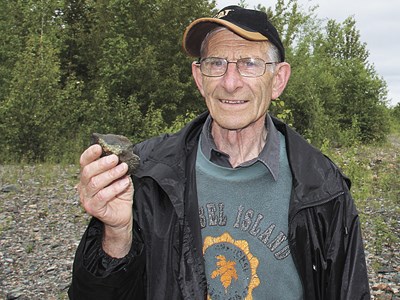By Bill Bradley
Editor’s note: This is the third story in a three-part series about prospecting.
Prospecting students had a lesson on gold exploration, including panning for gold, at Trueclaim Exploration’s Scadding Mine site by Kukagami Lake Road. The company is based in London, Ont.
They were participating in the Sudbury Prospector and Developers Association’s (SPDA) introductory prospecting course, held recently.
“I am enjoying this — I might get rich,” Todd Nelder, an exploration survey technician, said while learning how to pan for gold from gravel.
“Being in northern Ontario, it is nice to know a little bit more about its leading industry,” he added.
“This is pretty exciting, finding gold,” Cheryl Myher said. “It’s something you don’t expect to find every day.”
The Sudbury resident said she’s had a personal interest in rocks since she was a child. She was one of the students in the class who was successful in panning for gold. Students were given a tour of the gold camp and its drilling sites as a practical component of the course.
They practised their orienteering skills with Laurentian University masters geology student Craig Fitchett. They saw how ore samples were handled and cut up with Trueclaim geotechnician Trevor Pacaud. They learned about how computer software contributes to better understanding of ore bodies with Lindsay Moss, project geologist for Trueclaim Exploration.
Between 1984 and 1990, the Scadding Mine site reportedly produced 914 kg of gold from 150,000 tonnes of ore, and graded at 7.2 grams per tonne, Moss said. The site, located about 18 miles northeast of Sudbury, was initially explored in 1971, with the first documented findings in 1978. Afterward, five zones of gold mineralization were found around the property.
Three shallow open pits and a deeper ramp, a 110-metre zone, were exploited by a variety of prospectors, she noted. Trueclaim, listed on the TSX-Venture stock exchange, has staked the entire 44,000-acre site.
“Historically, you had small-scale prospectors with a claim here and there, but no one talked to each other,” Moss said. “When you have one company with all the claims then you can do a wide-scale investigation.”
Trueclaim’s Phase 1 drilling in late 2009 and early 2010 resulted in 33 drill holes, totaling 3,275 metres drilled into the rock.
“We wanted to see if the historical (gold mineralization) values that were reported were correct,” Moss said.
The best Trueclaim grade, in the northern part of the property, was 12.9 grams of gold per tonne of ore across 19.29 metres of rock.
Trueclaim is currently involved in an 8,000-metre drilling program. This year, 49 holes were drilled, Moss said.
Moss said the company bought Surpac, a 3D computer modeling software program, in December 2009. This was instrumental in targeting the mineralized zones and planning the best drilling programs to further test the grades of the ore.
“It is a very visual tool — a picture is worth a thousand words,” she said. “You can see how an ore body is sitting and how past drilling was often very chaotic. Standing on the surface they could not see the ore body the way we can now.”
Geologists have trouble conveying geological information to senior company officials or even investors, she said. But when she can show them visually the length, depth and width of the deposit, she can better explain where drilling work needs to be concentrated to fill in the gaps in knowledge about the ore body.
This kind of software is so new, universities aren’t even using it yet, Moss said. “This year, I gave a course on 3D modeling to Laurentian University students.”
Mike Horne, a retired Cambrian College chemistry professor, said he found the 3D modeling fascinating. “I am impressed,” he said.
However, he said the traditional role of the prospector on foot, examining rock outcrops in the field, was still just as important to him. He said he joined the SPDA two years ago on the recommendation of friends. He found the chemistry involved in geology interesting.
Horne grew up in Cornwall, England, where tin and copper were mined as far back as Roman times. He recalled visiting the old mines as a child.
Joshua Bailey, the prospecting course organizer and second vice-president of the SPDA, said he received great feedback from the students, with many suggesting more time could have been spent looking at rocks.
As a bonus, his organization had 17 new members join. “I am really happy with how it went,” he said.
For more prospecting course information, e-mail [email protected]
Bill Bradley is a freelance reporter. Contact him at [email protected].
- Posted by Vivian Scinto
Join Sudbury.com+
- Messages
- Post a Listing
- Your Listings
- Your Profile
- Your Subscriptions
- Your Likes
- Your Business
- Support Local News
- Payment History
Sudbury.com+ members
Already a +member?
Not a +member?
Sign up for a Sudbury.com+ account for instant access to upcoming contests, local offers, auctions and so much more.
